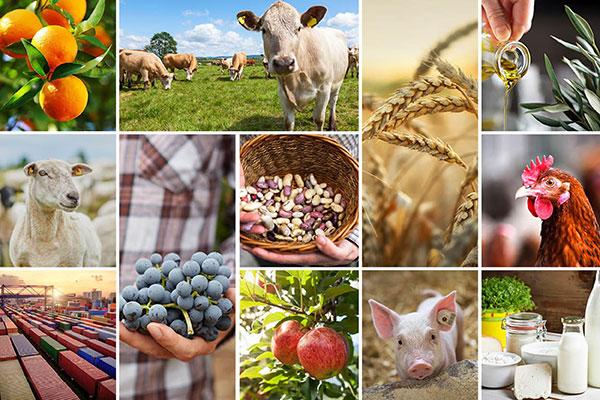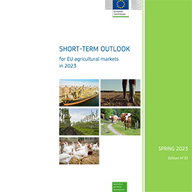
The negative impacts of Russia’s invasion of Ukraine, and the ensuing high input costs and food inflation, continue to weigh on agricultural markets and consumers’ purchasing decisions. In addition, large parts of the EU experienced winter droughts after the hot and dry summer of last year, further worsening water availability in regions with already record low water reservoirs. This might lead impacted farmers to substitute away from more water-intensive crop cultures. The current EU macroeconomic forecast is relatively more positive than in autumn 2022, despite uncertainties about energy supply for next winter and recent financial market tensions. High commodity prices last year helped countering high input costs and farm income increased on average, with significant sectorial and regional disparities.
The latest short-term outlook report shows that the lowering energy inflation could bring some relief regarding input prices. Fertilisers, especially nitrogen-based ones, could become more available and affordable compared with 2022. That being said, fertiliser and energy prices are still twice as high as at the beginning of 2020. Farmers have started adapting to this new situation, also responding to environmental and climate measures. They are indeed increasingly opting for crops with lower fertiliser needs, and the mineral fertiliser use is expected to be below long-term average in the upcoming season too.
Food inflation remains significant, with EU average food prices 19.5% higher in February 2023 than in February 2022. Consumers are expected to purchase more basic, cheaper food items and to shift preferences between different types of food, for example consume more poultry and less beef. Despite declines observed in some input costs, food prices are expected to remain at high level for a while before turning downwards.
Drought and climate events will impact the supply of certain agricultural products. The EU olive oil production in 2022/2023 decreased by almost 40% year-on-year, leading to higher prices. In some cases, in additional to lower supplies, the quality could also be impacted. This is the case for example of the EU orange harvest in 2022/2023.
Besides weather and cost-related production restrictions, animal diseases add to the uncertainty to the prospects of EU livestock production. The poultry sector suffered outbreaks of avian flu, while the pigmeat sector was affected by the African Swine Fever. This leads to reduced EU exports of these products.
This is the context for the European Commission’s spring 2023 edition of the short-term outlook report for EU agricultural markets. Published by the European Commission on 30 March 2023, the report presents a detailed overview of the latest trends and prospects for a range of agri-food sectors.
Arable crops
The hot and dry weather impacted the EU cereal production in 2022/2023, in particular maize with yields that dropped by 25%. Increasing imports from Ukraine help EU regions impacted by drought to satisfy their domestic use, most of which is taken by the feed demand. The EU continues to increase its exports of wheat (+9.4%, 32 million tonnes) to respond to global demand.
Total EU cereal production in 2023/24 could reach 288.4 million tonnes (+8.6% year-on-year), assuming normal weather conditions. An anticipated decrease in EU meat production is expected to reduce the use of cereals for feed, while food use is due to increase lightly.
EU oilseed production in 2023/24 could increase by 7% year-on-year to reach a new record of 33.6 million tonnes. The EU sugar beet area in 2023 is forecast to drop 3% below the 5-year average to 1.455 million hectares but yields are expected to be in line with the long-term average, resulting in a sugar beet production of around 111 million tonnes.
Specialised crops
The lower production of olive oil, in addition to high input costs, could lead to higher consumer and export prices. As a result, both EU consumption and exports are expected to drop (after a record level of exports recorded last year). Contrary to olive oil production, EU wine production is increasing and EU exports would remain stable, at 3% above the 5-year average.
Almost half of the production of apples is expected to be channelled to processing. This is a result of a higher availability of lower-quality apples not suitable for fresh consumption, their low prices, lower export opportunities and high energy costs for storage. Consumption of fresh apples could go down (but less than in some other types of fruit) while the consumption of processed apples will increase thanks to higher availability of products and consumer decisions to buy processed products instead of fresh ones, of a higher price.
Milk and dairy products
EU milk production remained rather stable in 2022, albeit with lower milk fat and milk protein content, and so reduced processing availability. It was notably hot and dry weather which impacted negatively quality and availability of grass and feed crops, as well as imposed a stress on dairy cows. In 2023, a declining EU raw milk price is likely to help slaughtering accelerate as feed and other input costs could remain high. Overall, EU dairy herd could shrink by 1%, and overall milk production by 0.2%. On the positive side, EU exports of cheese could grow by 2%, driven by a demand recovery in China and a stable UK and US demand.
Meat products
EU beef production decreased in 2022 by 2.4%, and is expected to decrease further in 2023 by 1.6%. The EU per capita beef consumption is expected to follow a long-term declining trend and could stay slightly below 10 kg in 2023 (-1.7%), also because beef is more expensive compared to other types of meat.
Likewise, EU pigmeat production decreased on average by 5.6%. Due to the limited supply, EU domestic use decreased by 2.8% in 2022, averaging at 31.8 kg per capita. This would further go down in 2023 by 5.5%.
EU poultry consumption could go up by 2.5%, and EU imports are expected to increase by 7% in 2023 to cover this demand growth.
More detailed information about production, consumption, and prices in these sectors and others can be found in the full spring 2023 short-term outlook report.

The short-term outlook for agricultural markets is published three times per year and is based on the latest data and information from market experts in the European Commission.
Details
- Publication date
- 30 March 2023
- Author
- Directorate-General for Agriculture and Rural Development
- Location
- Brussels




